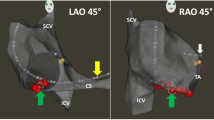Abstract
Radiofrequency catheter ablation of typical atrial flutter at the isthmus between the tricuspid annulus and the inferior vena cava is established. However in selected patients, the creation of a continuous linear lesion at the targeted isthmus requires a lengthened procedure or is not feasible at all and atrial flutter recurrences are common.
In a retrospective analysis, we found that an intraoperatively determined distance between the tricuspid annulus and the inferior vena cava of <.2.5 cm is an independent predictor of a lengthened or failed ablation procedure. Additional equipment, e.g., long introducer sheaths, adapted ablation catheter design, or irrigated tip ablation, as well as alternative ablation approaches, e.g., linear lesions between the tricuspid annulus and Eustachian ridge, have been invented in order to increase the acute success rate or decrease fluoroscopy and procedure time.
In a prospective study on the effects of various conduction properties at the isthmus between tricuspid annulus and inferior vena cava following radiofrequency ablation of atrial flutter, we showed previously that others than a complete bidirectional conduction block predicts a high recurrence rate of atrial flutter. For determination of transisthmal conduction properties following ablation, established mapping approaches are documentation of double potentials at the ablation line and right atrial activation sequence following posteroseptal and low lateral right atrial pacing. Novel threedimensional mapping systems, i.e., Carto® and EnSite®, may further enhance the accuracy of conventional mapping techniques.
Similar content being viewed by others
References
Saoudi N, Atallah G, Kirkorian G, et al. Catheter ablation of the atrial myocardium in human type I atrial flutter. Circulation 1990;81:762–771.
Feld GK, Fleck RP, Chen PS, et al. Radiofrequency catheter ablation for the treatment of human type I atrial flutter: Identification of a critical zone in the reentrant circuit by endocardial mapping techniques. Circulation 1992;86: 1233–1240.
Cosio FG, Lopez-Gil M, Goicolea A, et al. Radiofrequency catheter ablation of the inferior vena cava-tricuspid valve isthmus in common atrial flutter. Am J Cardiol 1993;71: 705–709.
Kirkorian G, Moncada E, Chevalier P, et al. Radiofrequency ablation of atrial flutter: Efficacy of an anatomically guided approach. Circulation 1994;90:2804–2814.
Calkins H, Leon AR, Deam AG, et al. Catheter ablation of atrial flutter using radiofrequency energy. Am J Cardiol 1994;73:353–356.
Steinberg JS, Prasher S, Zelenkofske S, et al. Radiofrequency catheter ablation of atrial flutter: Procedural success and long-term outcome. Am Heart J 1995;130:85–92.
Poty H, Saoudi N, Aziz AA, et al. Radiofrequency catheter ablation of type 1 atrial flutter: Circulation 1995;92: 1389–1392.
Fischer B, Jais P, Shah D, et al. Radiofrequency catheter ablation of common atrial flutter in 200 patients. J Cardiovasc Electrophysiol 1996;7:1226–1233.
Chen SA, Chiang CE, Wu TJ, et al. Radiofrequency catheter ablation of common atrial flutter: Comparison of electrophysiologically guided focal ablation technique and linear ablation technique. J Am Coll Cardiol 1996;27:860–868.
Tai CT, Chen SA, Chiang CE, et al. Electrophysiologic characteristics and radiofrequency catheter ablation in patients with clockwise atrial flutter. J Cardiovasc Electrophysiol 1997;8:24–34.
Schumacher B, Lewalter T, Wolpert et al. Radiofrequency ablation of atrial flutter. J Cardiovasc Electrophysiol 1998; 9:S139-S145.
Schmidt T, Schumacher B, Lewalter T, et al. Predictive value of various parameters for a successful catheter ablation of typical atrial flutter. Eur Heart J 1998;19:542 (Abstract).
Jais P, Haissaguerre M, Shah DC, et al. Successful irrigatedtip catheter ablation of atrial flutter resistant to conventional radiofrequency ablation. Circulation 1998;98:835–838.
Nakagawa H, Lazzara R, Kasthgir T, et al. Role of the tricuspid annulus and the eustachian valve/ridge on atrial flutter. Circulation 1996;94:407–424.
Schumacher B, Lewalter T, Wolpert C, et al. Linear lesion between the tricuspid annulus and the inferior vena cava or the Eustachian ridge: Which is the preferrable approach for ablation of atrial flutter? J Am Coll Cardiol 1998;30:401 (Abstract).
Poty H, Klug D, Scanu F, et al. Randomized comparison of two targets in ablation of common atrial flutter. Eur Heart J 1997;18:150 (Abstract).
Schumacher B, Pfeiffer D, Tebbenjohanns J, et al. Acute and long-term effects of consecutive radiofrequency applications on conduction properties of the subeustachian isthmus in type I atrial flutter. J Cardiovasc Electrophysiol 1998;9: 152–163.
Cauchemez B, Haissaguerre M, Fisher B, et al. Electrophysiological effects of catheter ablation of inferior vena cava-tricuspid annulus isthmus in common atrial flutter. Circulation 1996;93:284–294.
Poty H, Saoudi N, Nair M, et al. Radiofrequency catheter ablation of atrial flutter: Further insights into the various types of isthmus block. Application to the ablation during sinus rhythm. Circulation 1996;94:3204–3213.
Schwartzman D, Callans DJ, Gottlieb CD, et al. Conduction block in the inferior vena caval-tricuspid valve isthmus: Association with outcome of radiofrequency ablation of type I atrial flutter. J Am Coll Cardiol 1996;28:1519–1531.
Author information
Authors and Affiliations
Rights and permissions
About this article
Cite this article
Schumacher, B., Wolpert, C., Lewalter, T. et al. Predictors of Success in Radiofrequency Catheter Ablation of Atrial Flutter. J Interv Card Electrophysiol 4 (Suppl 1), 121–125 (2000). https://doi.org/10.1023/A:1009851119938
Issue Date:
DOI: https://doi.org/10.1023/A:1009851119938




